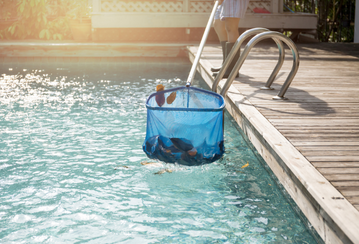News and Updates
10 tips for winterizing your swimming pool
As summer winds down and you start looking forward to fresh apple pies and crisp fall leaves, it’s time to also begin thinking about closing your swimming pool for the year. All good things must come to an end, but there’s always next summer to look forward to! Following the right steps to close and winterize your pool now helps make for a hassle-free opening so that you can make the most of the next swim season.
Here are our 10 tips for safely closing and winterizing your swimming pool:
-
Deep clean the pool.
Skim and vacuum your pool to remove debris, then brush your pool’s surfaces with a non-abrasive cleaner before covering it for the cooler seasons. This helps prevent algae from growing and makes for less spring cleaning when you re-open your pool next year.
-
Look for damage.
Inspect your pool carefully for leaks, cracks, and other types of damage. Even a small crack can become a big problem once the temperature drops below freezing. If you do notice damage, contact a trusted professional to schedule a repair before closing up for the season.
-
Test and balance the water.
Use a pool test kit to measure and balance your pool’s pH, alkalinity, and calcium hardness according to the manufacturer’s instructions. Balancing the water chemistry helps protect your pool against staining, etching, and corrosion.
-
Add shock, chlorine, and algaecide.
Shock and chlorinate your pool once the water’s been balanced to kill any stubborn bacteria that might stick around even after temperatures drop. Add algaecide to get rid of existing algae and prevent more from forming. If you aren’t sure which chemicals to use, contact your local pool supply store for help.
-
Backwash the pool filter.
Clean out your pool’s filter by backwashing it according to the manufacturer’s instructions. This will flush out any buildup inside so it’s ready to go for next season.
-
Lower the water level.
Lower your pool’s water level according to the manufacturer’s recommendation. Typically, for vinyl-lined pools, this means 4-6 inches below the skimmer, and for plaster pools just below the tile line. Do not completely drain the pool water, as this risks damage to the pool liner and cover.
-
Drain and store pool equipment.
Completely drain all water from your pool’s pump, heater, and filter. Water left inside this equipment could cause damage once it freezes. Disconnect and store equipment safely for the season, alongside any decorative pool fittings like ladders, baskets, and water toys.
-
Winterize the pipes.
Clear all water from your pool’s pipes using a wet-dry shop vacuum or air compressor to avoid potential freezing damage. If you live in a cold winter climate like Ontario and are expecting harsh weather, consider adding pool antifreeze to the pipes as an extra precaution.
-
Cover the pool.
Invest in a good-quality winter pool cover that secures tightly around your pool to keep it clear of debris during the off-season. It should ideally be strong enough to withstand the weight of ice and snow and protect people and pets from accidentally falling through. Repair any rips or tears and replace the cover when necessary.
-
Set a pool alarm.
A pool alarm detects and notifies you of unwanted entry into a pool or pool area so you can take action. This is especially important if there are young children or pets nearby.
Thinking about installing a swimming pool next season or have questions about how your current pool impacts your home insurance? Contact your OTIP insurance broker at 1-833-494-0089 to discuss your coverage options or call 1-833-615-9326 to get a quote for home insurance.





